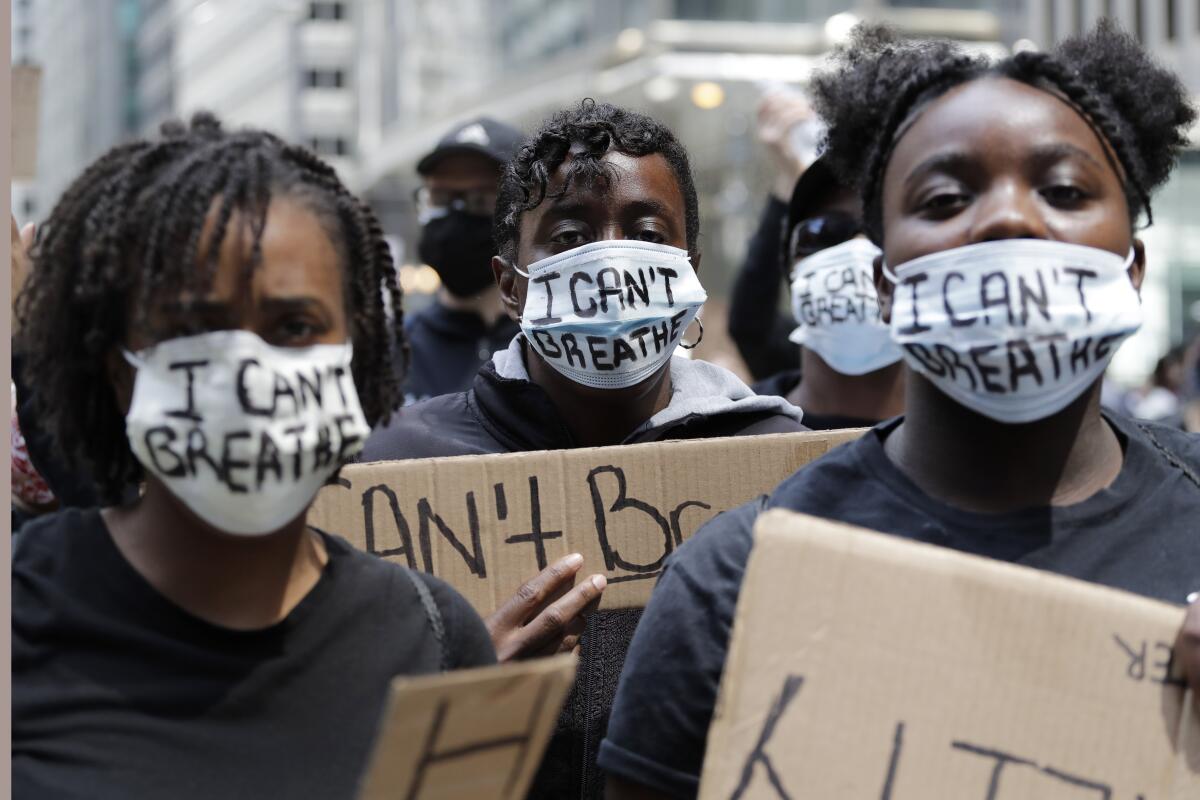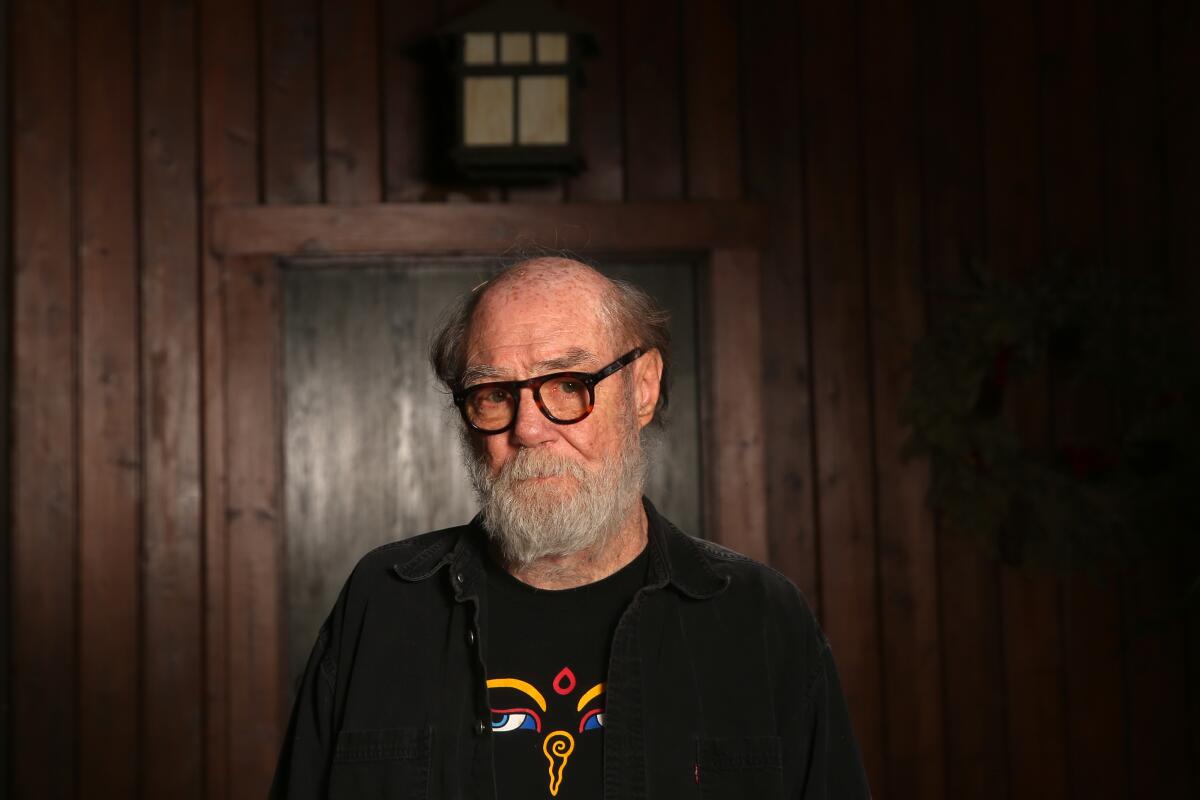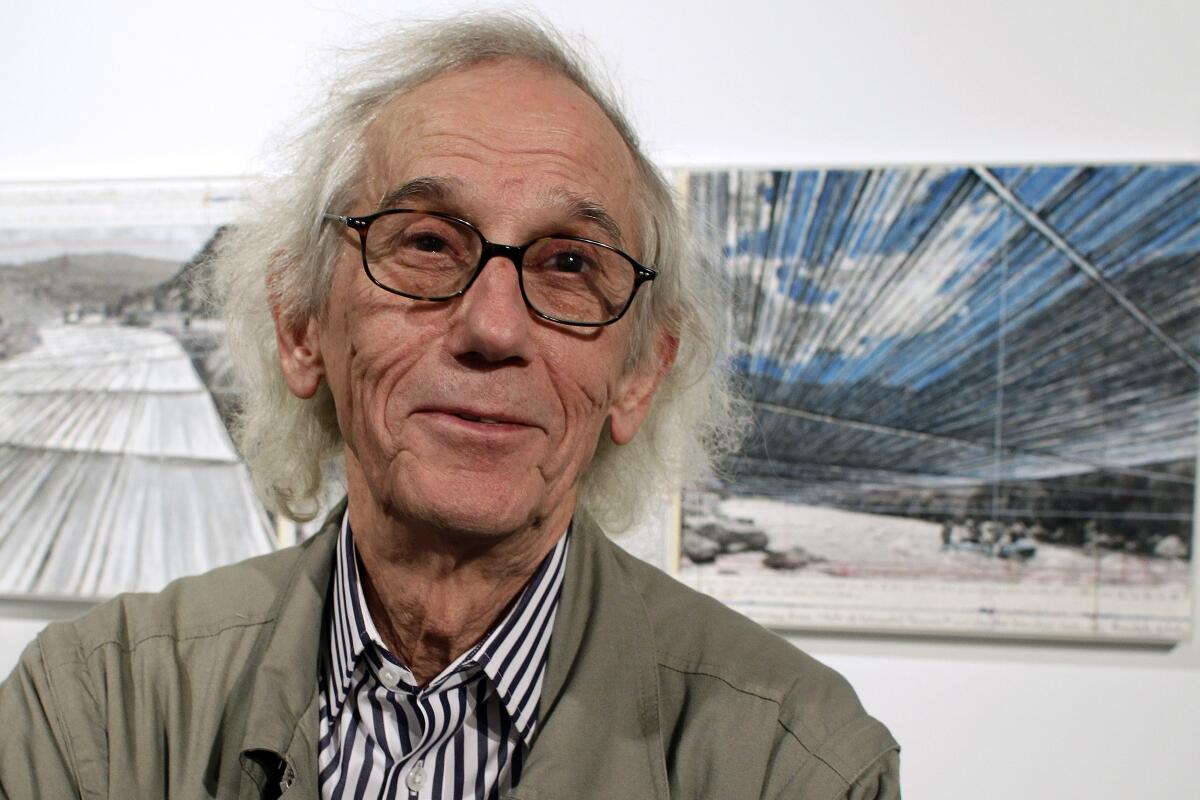Newsletter: Essential Arts: An outpouring of art in support of black lives
- Share via
Let’s kick off with a passage from Ta-Nehisi Coates’ “Between the World and Me,” a book that takes the form of a letter written by a black father to his son:
“The price of error is higher for you than it is for your countrymen, and so that America might justify itself, the story of a black body’s destruction must always begin with his or her error, real or imagined — with Eric Garner’s anger, with Trayvon Martin’s mythical words (‘You are gonna die tonight’), with Sean Bell’s mistake of running with the wrong crowd.”
In George Floyd’s case, the mistake was allegedly, and probably unknowingly, using a counterfeit bill.
I’m Carolina A. Miranda, staff writer at the Los Angeles Times, with the week’s essential culture news:
Essential reading
The pain uncapped by Floyd’s brutal death has led us to reflect on our culture — and whether it can rise to meet its imagined ideals.
Kareem Abdul-Jabbar wrote an extraordinary essay for The Times about what the protests encapsulate: “What you should see when you see black protesters in the age of Trump and coronavirus is people pushed to the edge, not because they want bars and nail salons open, but because they want to live. To breathe.”

This roiling moment, writes Jamelle Bouie in the New York Times, reflects “the pressures and conflicts of a diversifying country; the struggle to escape an exclusive past for a more inclusive future; and our constant battle over who truly counts — who can act as a full and equal member of this society — and who does not.”
Make the most of L.A.
Get our guide to events and happenings in the SoCal arts scene. In your inbox every Monday and Friday morning.
You may occasionally receive promotional content from the Los Angeles Times.
“Hundreds of enslaved black people,” writes DeNeen L. Brown of the Washington Post, once “were held captive within sight of the White House.” Brown has a history of Washington, D.C.’s Lafayette Square, cleared by force for the president’s photo op. Brown tracks this and other historical slave sites around our nation’s capital.
Robin Givhan critiques the photo that came out of that photo op: “He didn’t go inside. Instead, the structure loomed behind him — a lemon-yellow, three-dimensional set for his tortured stage play.”
“Ours is a history of the depravity of literal and metaphorical white boots on black necks, from the placement of shackles and yokes on the necks of enslaved people forced to march in coffles to iron collars deployed as punishments to enslaved people who dared attempt escape.” Critic Soraya Nadia McDonald considers Floyd’s death along with this very vulnerable piece of human anatomy.
“The most urgent filmmaking anybody’s doing in this country right now is by black people with camera phones.” New York Times critic Wesley Morris on the “ghastly visual mosaic of mistreatment.”
“No one can ignore a black woman sitting on top of a horse.” An image of Brianna Noble riding her steed amid the protests in Oakland has become a defining image of the uprisings.

Priska Neely on getting a pile of text messages checking in to see if she’s OK: “The barrage of guilt-tinged texts from white associates did force me to try to nail down the most unanswerable question, So, how am I?”
“At the time, these rules felt annoying,” writes Brianna Holt of her parents’ strictness, “but as I got older, I realized they were necessary.”
Lorraine Berry has a Black Lives Matter reading guide with lots and lots of ideas and links.
As difficult as the past week has been, Ta-Nehisi Coates says of the actions, “I see hope. I see progress right now.”
Culture and the protests
On Tuesday, a figure of a lone Confederate soldier, which has stood in Alexandria, Va., was removed from its pedestal. Times art critic Christopher Knight looks at how the protests have led to a wave of Confederate monument removals — and not a moment too soon. “Memorial sculptures like this one have a specific purpose,” he writes. “They cast institutional racism in bronze.”

Plus, Ben Davis at Artnet looks at how statuary around the country has served as targets during the protests.
Viral illustrations have helped keep the memories of the victims of police violence alive in artful ways. Times intern Megan Botel reports on how writer Cate Young (with the help of illustrator Ariel Sinha) is working to lift the profile of Breonna Taylor’s case. (She was the 26-year-old EMT who was shot by police in her Kentucky apartment in March.)
Times culture writer Makeda Easter reports on the viral artworks that have emerged in the wake of George Floyd’s death. “The art is a way to uplift lives often reduced to violent images and videos in media coverage,” she writes, “and to serve as a call to action.”
Support our journalism
In the meantime, in the world’s largest artistic subtweet, D.C. Mayor Muriel E. Bowser renamed the street in front of the White House “Black Lives Matter Plaza” and had the sidewalk painted with massive yellow letters that state much the same.
Related: Kriston Capps writes about how the protests are shaping public space in D.C., from the temporary fence that has sprung up around the White House to the sealing off of popular gathering and protest spaces.

Times classical music critic Mark Swed recommends this conversation hosted by L.A. Opera and led by mezzo-soprano J’Nai Bridges. Along with fellow performers Morris Robinson, Russell Thomas, Karen Slack, Julia Bullock and Lawrence Brownlee, she discusses racial disparities and inequality in opera. Swed describes the discussion as “cogent, radical and riveting.”
And Theresa Ruth Howard says it’s time for the dance community to publicly acknowledge “when Black bodies are in peril.”
Plus: the National Museum of African American History and Culture has launched an online portal called “Talking About Race.”
Other culture updates
The pandemic has shut down the Tony Awards. But thankfully, we have the Charlies — a.k.a. Times theater critic Charles McNulty’s top choices for the best of Broadway over the past decade. “The Tonys are for hailing virtuosity,” he writes. “The Charlies are for remembering it and arguing over it. Have at me!” Who got best director? And who got best play? You’ll have to click through to see the winners. ;-)
Reporter Ashley Lee has been hitting the television musicals — namely, “Central Park,” a new animated series on Apple+ TV. She gets the backstory on three of the show’s tunes, which feature “clever punchlines, catchy hooks and thoughtful commentary on real-world matters.”
How might U.S. museums make a comeback after the pandemic? The Times’ Deborah Vankin has a look at the new practices at Guggenheim Bilbao, which reopened Monday. These include temperature checks, masks and virtual tours via cellphone app rather than shared headsets.
I had an opportunity to catch up with L.A. artist Paul McCarthy, whose solo show of drawings at the Hammer Museum was shut down by the governor’s safer-at-home order. We talk about drawing, that time he ran around with a Pampers box on his head and why he likes to lurk on Instagram.

I also write about an attempt by two New York galleries to collectively resuscitate an installation by the late artist Felix Gonzalez-Torres, but which ended up feeling like Instagram eye candy. At a time of such staggering need, “the photo ops,” I note, “feel like fancy pink salt in the collective wound.”
The best arts online
A new doc by director Daniel Traub examines the artist’s life in “Ursula von Rydingsvard: Into Her Own.” And Times deputy film editor Kevin Crust says it’s a film that foregrounds the tactility of the artist’s massive wood sculptures (works partly inspired by a youth spent in refugee camps). “This is work you want to touch,” he writes, “despite that being one of the less cinematic senses.”
Plus, my colleague Matt Cooper has been rounding up the best art online, including a seven-day stream of Tom Hiddleston in Shakespeare’s “Coriolanus” and the comedy specials of “Parks and Recreation” star Nick Offerman.
In February, Black Lives Matter founder Patrisse Cullors staged a performance at the Broad museum inspired by intersecting themes of family and criminal justice reform. The museum has now put video of “Prayer to the Iyami” online.
Plus, revisting a photo essay by Kwasi Boyd-Bouldin that documents sites of police violence around Los Angeles.
Passages
Christo, the artist known for massive environmental art projects that included wrapping Berlin’s Reichstag and planting 1,760 yellow umbrellas in Southern California in 1991, died last weekend at the age of 84. Of his chosen material, he once said: “fabric is very sensual and inviting; it’s like skin.”

Elsa Dorfman, the Boston photographer who became known for making portraits with a rare Polaroid camera that weighed 200 pounds, has died at 83.
In other news
— A group of scientists says that choral singing risks coronavirus transmission, even though the Centers for Disease Control and Prevention has dropped a warning about it from its website.
— Art organizations are dipping into their endowments.
— The Metropolitan Opera has canceled its fall performances.
— Jane Moss is leaving her longtime post as artistic director at Lincoln Center.
— How the Nasher Sculpture Center’s program for visitors with Alzheimer’s has found a wide following online during the pandemic.
— McMansion Hell founder Kate Wagner on “coronagrifting” in the design world.
— People are sawing through Trump’s border wall.
And last but not least ...
Rapper Killer Mike’s incredible speech about George Floyd’s death and the protests it generated.
The biggest entertainment stories
Get our big stories about Hollywood, film, television, music, arts, culture and more right in your inbox as soon as they publish.
You may occasionally receive promotional content from the Los Angeles Times.




